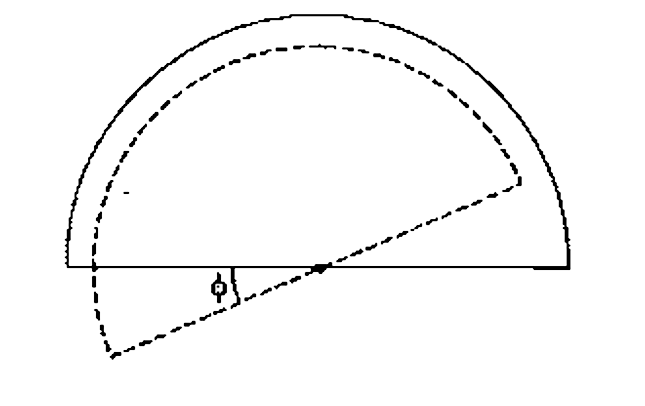A capacitor consists of two stationary plates shaped as a semi-circle of radius R adn a movable plate made of dielectric with permittivity ε and capacble of rotoning about an axis O between the stationary plates (fig). The thickness of the movables plate is equal to d which is practically the separation between teh stationary plates. A potential difference V is applied to the capacitor. FInd the magnitude of the moment of forces relative to the axis O acting on teh movable plate in the position shown in the figure.

When the capacitor is kept at a contant potential difference V, the work performed by the moment of electrostatic forces between the plates when the inner moveable plate is rotated by an angel dφ equals the increases in the potential energy of the system. This comes about because when chagres are made, chagres flow from the battery to keep the potential constant and the amount of the work done by these charges is twice it magnitude and opposite in sign to the change in the energy of the capacitor Thus
Nz=∂U∂φ=12V2∂C∂φ
Now the capacitor can be thought of as made up two parts (with and without the dielectric) in parallel.
Thus C=εR2φ2d+ε0ε(π−φ)R22d
as the area of a sector of angle φ is 12R2φ. Defferenctian then gives
Ns=−(ε−1)ε0R2V24d
The negative sign of Nx indicates that the moment of the force is acting clockwire (i.e., trying to suck in the-dielectric).
Topper's Solved these Questions
- ELECTRODYNAMICSBOOK - IE IRODOV, LA SENA & SS KROTOVCHAPTER - ELECTRODYNAMICSEXERCISE - Electric Current
72 Videos
- ELECTRODYNAMICSBOOK - IE IRODOV, LA SENA & SS KROTOVCHAPTER - ELECTRODYNAMICSEXERCISE - Constant Magnetic Fiels - Magnetics
69 Videos
- ELECTRODYNAMICSBOOK - IE IRODOV, LA SENA & SS KROTOVCHAPTER - ELECTRODYNAMICSEXERCISE - Conductors And Dielectrics In An Electric Field
47 Videos
- ELECTRICITY AND MAGNETISMBOOK - IE IRODOV, LA SENA & SS KROTOVCHAPTER - ELECTRICITY AND MAGNETISMEXERCISE - All Questions
6 Videos
- ELECTROMAGNETISMBOOK - IE IRODOV, LA SENA & SS KROTOVCHAPTER - ELECTROMAGNETISMEXERCISE - All Questions
24 Videos
Similar Questions
A capacitor consists of two stationary plates shaped as a semi-circle of radius R and a movable plate made of dielectric with permittivity K and capable ofrotating about an axis O between the stationary plates. The thickness of movable plate is equal to d which is practically the separation between the stationary plates. A potential difference V is applied to the capacitor. Find the magnitude of the moment of forces relative to the axis O acting on the movable plate in the position shown in figure.

View SolutionA parallel plate capacitor having plate area A and separation between the plates d is charged to potential V.The energy stored in capacitor is ....???
View Solution
Knowledge Check
The capacitance of a capacitor depends on
(A) Charge on the plates
(B) the size of the plates
(C) the shape of the plates
(D) the separation between the platesAA,B,CBA,C,DCB,C,DDA,B,DThe capacitance of a parallel plate condenser is C0 If a dielectric of relative permittivity εr and thickness equal to one fourth the plate separation is placed between the plates, then its capacity becomes C. The value of CC0 will be -
A5εr4εr+1B4εr3εr+1C3εr2εr+1D2εrεr+1The separation between the plates of a parallel plate capacitor is d and the area of each plate is A. iff a dielectric slab of thickness x and dielectric constant K is introduced between the plates, then the capacitance will be
Aε0Ad−x(1−1K)Bε0Ad+x(1−1K)Cε0Ad+x(1+1K)Dε0Ad−x(1+2K)
The capacitance of a parallel plate condenser is C0 If a dielectric of relative permittivity εr and thickness equal to one fourth the plate separation is placed between the plates, then its capacity becomes C. The value of CC0 will be -
View SolutionThe distance between the plates of a parallel plate capacitor is 'd'. The capacitance of the capacitor gets doubled when a metal plate of thicknessd2 is placed between the plates.
View SolutionA parallel plate capacitor is charged by a battery . After sometime the battery is disconnected and a dielectric slab with its thickness equal to the plate separation is inserted between the plates . How will potential difference between the plates ? Justify your answer
View SolutionA dielectric slab is inserted between the plates of an isolated capacitor. The force between the plates will
View SolutionThe capacitance of a parallel plate condenser is C0 If a dielectric of relative permittivity εr and thickness equal to one fourth the plate separation is placed between the plates, then its capacity becomes C. The value of CC0 will be -
View Solution
